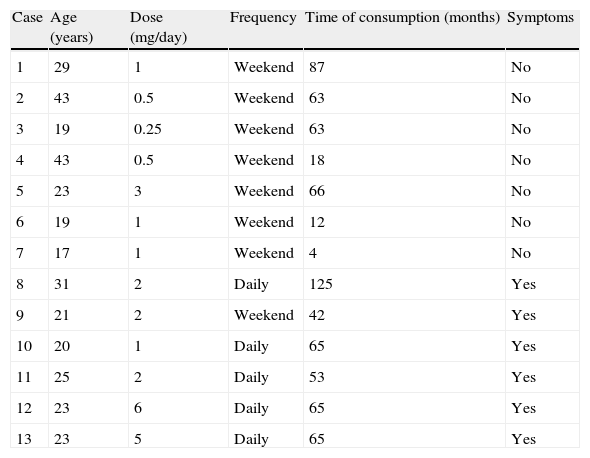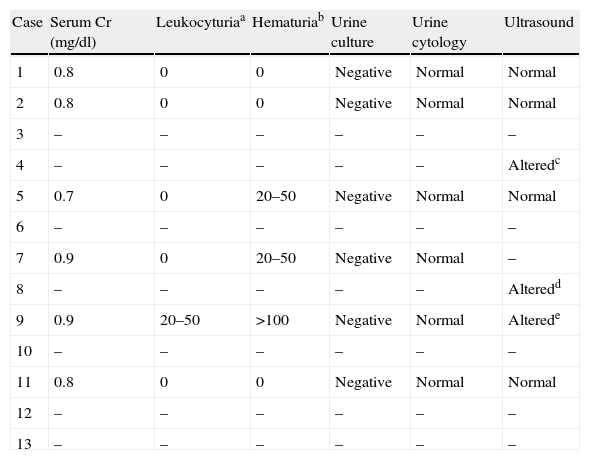To analyze the prevalence of lower urinary tract symptoms (LUTS) in recreational ketamine users and evaluate its relationship with the consumption pattern.
Material and methodsEvaluation of 13 ketamine users. The presence of LUTS, gross hematuria and lumbar spine pain was analyzed. The ketamine usage pattern was recorded: initiation, administration route, dose in the last month, and frequency of usage.
ResultsSix patients (46%) reported LUTS, with daily mean micturations every 42min and nighttime of 3 episodes, with dysuria (100%), urgency (100%), incontinence (20%), decreased flow (80%), hypogastric or perineal pain (80%), gross hematuria (80%) and bilateral lumbar spine pain (40%). Symptomatic patients described a mean intake of inhaled ketamine of 3g/day (SD 2), 80% with a daily frequency and the asymptomatic ones of 1.03g/day (SD 0.92) limited to weekends. The mean consumption time to the appearance of the symptoms was 31 months (SD 16.29). Intensity of the symptoms was related with the ketamine dose and improved on increasing water intake.
ConclusionsThere seems to be a relationship between the picture with the dose and frequency of consumption, there being factors that reinforce the hypothesis that this action of the drug is due to the harmful effect on the urothelium. The process to identify it on time should be known, since the only known effective measure is to stop the consumption in the initial phases.
Analizar la prevalencia de sintomatología del tracto urinario inferior (STUI) en consumidores de ketamina con fines recreativos y valorar su relación con el patrón de consumo.
Material y métodosValoración de 13 consumidores de ketamina. Se analizó la presencia de STUI, hematuria macroscópica y dolor lumbar. Se registró el patrón de consumo de ketamina: inicio, vía de administración, dosis en el último mes y frecuencia de consumo.
ResultadosSeis pacientes (46%) refirieron STUI, con un ritmo diurno medio de micciones cada 42 minutos y nocturia media de 3 episodios, con disuria (100%), urgencia (100%), incontinencia (20%), disminución del caudal (80%), dolor hipogástrico o perineal (80%), hematuria macroscópica (80%) y dolor lumbar bilateral (40%). Los pacientes sintomáticos describieron un consumo medio de ketamina inhalada de 3g/día (DE 2), el 80% con una frecuencia diaria, y los asintomáticos de 1,03g/día (DE 0,92) limitado a los fines de semana. El tiempo medio de consumo hasta la aparición de los síntomas fue de 31 meses (DE 16,29). La intensidad de la sintomatología se relacionó con la dosis de ketamina, y mejoró al aumentar la ingesta hídrica.
ConclusionesParece haber una relación del cuadro con la dosis y la frecuencia de consumo, existiendo factores que refuerzan la hipótesis de que esta acción de la droga se debe a su efecto lesivo sobre el urotelio. Hay que conocer el proceso para identificarlo a tiempo, ya que la única medida efectiva conocida es abandonar el consumo en las fases iniciales.








